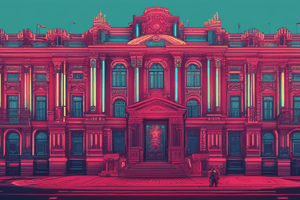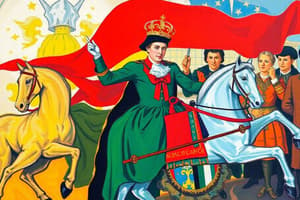Podcast
Questions and Answers
What was a key demand of the protesters on Bloody Sunday?
What was a key demand of the protesters on Bloody Sunday?
- Nationalization of industries
- Establishment of a Soviet government
- Abolition of serfdom
- Creation of a constituent assembly (correct)
What was a major consequence of the 1905 Russian Revolution?
What was a major consequence of the 1905 Russian Revolution?
- The beginning of World War I
- The weakening of the monarchy and paving the way for future revolutions (correct)
- The abolition of the monarchy
- The establishment of a socialist government
What was the immediate trigger for the Bloody Sunday uprising?
What was the immediate trigger for the Bloody Sunday uprising?
- A workers' strike in St. Petersburg
- A petition to Nicholas II for better working conditions and higher wages (correct)
- A protest against the Russo-Japanese War
- The assassination of a government official
What was a key concession made by the government in response to the 1905 Russian Revolution?
What was a key concession made by the government in response to the 1905 Russian Revolution?
What was a major goal of the 1905 Russian Revolution?
What was a major goal of the 1905 Russian Revolution?
What was a major flaw in Nicholas II's leadership style?
What was a major flaw in Nicholas II's leadership style?
What was the primary goal of the peasant uprisings during Nicholas II's reign?
What was the primary goal of the peasant uprisings during Nicholas II's reign?
What was the response of the government to the peasant uprisings?
What was the response of the government to the peasant uprisings?
What event on January 22, 1905, marked a turning point in the 1905 Russian Revolution?
What event on January 22, 1905, marked a turning point in the 1905 Russian Revolution?
What was the primary motive behind the Russian nobility's support for Nicholas II's autocratic rule?
What was the primary motive behind the Russian nobility's support for Nicholas II's autocratic rule?
What was a significant consequence of Nicholas II's failure to address Russia's social and economic problems?
What was a significant consequence of Nicholas II's failure to address Russia's social and economic problems?
Flashcards are hidden until you start studying
Study Notes
Nicholas II's Reign
- Last emperor of Russia, ruling from 1894 to 1917
- Inherited the throne at the age of 26, lacking experience and leadership skills
- Autocratic ruler, believing in the divine right of kings
- Focused on maintaining the traditional social hierarchy and the power of the nobility
- Failed to address the country's social and economic problems, leading to widespread discontent
Russian Nobility
- Owned most of the land and held significant power and influence
- Dominated the government and the bureaucracy
- Lived luxuriously, while the majority of the population struggled with poverty and hunger
- Supported Nicholas II's autocratic rule, fearing loss of power and privileges
Peasant Uprisings
- Peasants made up the majority of the Russian population, living in poverty and exploited by the nobility
- Frequent uprisings and protests occurred throughout Nicholas II's reign, demanding land reform and better living conditions
- Government responded with repression and violence, further fueling the peasants' discontent
Bloody Sunday
- January 22, 1905: Thousands of workers, led by Father Gapon, marched to the Winter Palace in St. Petersburg to present a petition to Nicholas II
- Demands included better working conditions, higher wages, and the creation of a constituent assembly
- The Imperial Guard opened fire on the unarmed protesters, killing and wounding hundreds
- Event sparked widespread outrage and protests, marking the beginning of the 1905 Russian Revolution
1905 Russian Revolution
- Series of protests, strikes, and uprisings that lasted throughout 1905
- Demands included political reform, civil liberties, and an end to the Russo-Japanese War
- Government responded with concessions, including the creation of the Duma (a legislative assembly) and the October Manifesto, which granted civil liberties and voting rights
- Revolution ultimately failed to achieve its goals, but it weakened the monarchy and paved the way for future revolutions
Nicholas II's Reign
- Last Russian emperor, ruled from 1894 to 1917
- Inherited throne at 26, lacking experience and leadership skills
- Autocratic ruler, believing in divine right of kings
- Focused on maintaining social hierarchy and nobility power
- Failed to address social and economic problems, leading to discontent
Russian Nobility
- Owned most land and held power and influence
- Dominated government and bureaucracy
- Lived luxuriously, while majority struggled with poverty and hunger
- Supported Nicholas II's autocratic rule, fearing loss of power and privileges
Peasant Uprisings
- Peasants made up majority of population, living in poverty and exploited by nobility
- Frequent uprisings and protests occurred, demanding land reform and better living conditions
- Government responded with repression and violence, fueling discontent
Bloody Sunday
- January 22, 1905: Thousands of workers marched to Winter Palace, demanding better working conditions, higher wages, and a constituent assembly
- Imperial Guard opened fire, killing and wounding hundreds
- Event sparked widespread outrage and protests, marking the beginning of the 1905 Russian Revolution
1905 Russian Revolution
- Series of protests, strikes, and uprisings throughout 1905
- Demands included political reform, civil liberties, and end to the Russo-Japanese War
- Government responded with concessions, including creation of the Duma and the October Manifesto
- Revolution ultimately failed to achieve its goals, but weakened the monarchy and paved the way for future revolutions
Studying That Suits You
Use AI to generate personalized quizzes and flashcards to suit your learning preferences.




